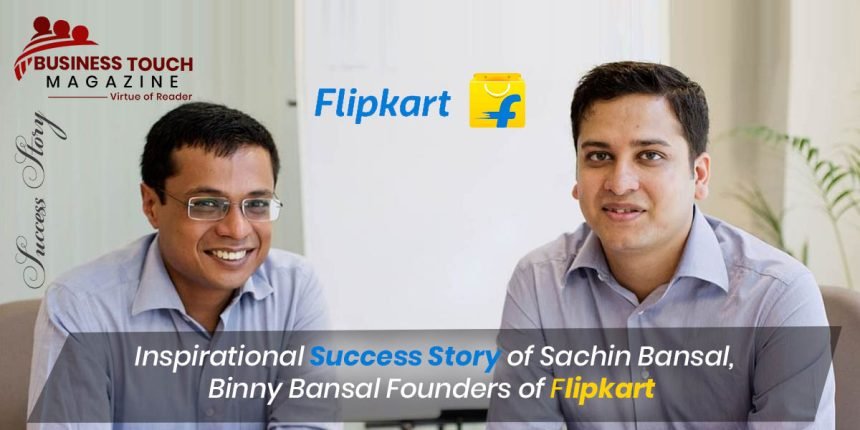With Walmart acquiring Flipkart, the latter is now valued at over $20 billion and the two founders, Sachin Bansal and Binny Bansal are multi-billionaires. When they started, their parents gave them Rs 10,000 a month as an allowance for almost 18 months. They had invested Rs 2 lakh each from their savings. It was in their two-bedroom flat in Bengaluru that the duo, who share a common interest in computer science, built the first version of the site, with just two computers. People who know them say they have different temperaments.
In 2007, Binny Bansal and Sachin Bansal realized that the E-commerce market in India was very small. After leaving Amazon in 2007, they planned to launch an online bookstore, later they founded Flipkart in a two-storeyed building in Koramangala as an e-commerce company. Both of them worked in Amazon, an American multinational technology company for a while before founding Flipkart.
In the early days, Binny Bansal and Sachin Bansal used to distribute books on their scooters. Direct e-commerce was not their first idea, it was to launch a price comparison site. Both being 2005 graduates from IIT Delhi, were formally exposed to the retail sector while working at Amazon. The two met at the workplace and explored their mutual interest in bringing about a change in the e-commerce industry of India. But market research led them to the idea of an e-commerce site, and thus, Flipkart was born in October 2007. And the rest is Indian start-up and e-commerce history.
Interesting Retails Ecommerce Sales growth report Worldwide:
Latin America – 36.7
North America – 31.8%
Central & Eastern Europe – 29.1%
Asia – Pacific – 26.4%
Western Europe – 26.3%
Middle East-Africa – 19.8%
Worldwide – 27.6%
Flipkart Journey on the path of success
It’s difficult to believe that a single small business can drastically change the way we shop. The company Flipkart has done exactly that. In 2007, e-commerce was still considered a dissimilar market, and the majority of Indians shopped offline. The Internet was taking over the world swiftly, and Steve Jobs had just released the world’s first iPhone, which was about to distress the whole smartphone market in the coming years.
“We were not thinking about numbers then, but we knew something big can be built out of e-commerce.”
- Binny Bansal and Sachin Bansal, the founders of Flipkart.
Two Indian software engineers, Sachin and Binny Bansal perceived the changing aspects of technology and saw the authority of E-commerce. While there were only 50 million internet users in India at the time, they understood that with the introduction of smartphones more Indians would join the internet.
Flipkart is among India’s leading e-commerce platforms. It was started in October 2007 with its headquarters residing in Bengaluru. The online undertaking had initially begun as an online bookstore but as the firm’s reputation intensified, it grew and expanded its actions. The platform started selling a variety of other products like music, mobile phones, as well as movies. With e-commerce progressively transforming the world of retail and reaping its momentum in India, Flipkart expanded at a fast pace steadily supplementing various new item categories in its collection.
Presently, the company facilitates over 80 million+ products across the range of over 80 categories from mobile phones & accessories, computers, laptops, books and e-books, home appliances, electronic goods, clothes and accessories, sports and fitness, baby care, games, and toys, jewellery, footwear, and so on.
Forbes India Rich List established its first recognition in 2015. Binny and Sachin Bansal were named India’s 86th wealthiest persons. Their combined net worth was estimated to be $1.3 billion. Despite the presence of Amazon.com and other e-commerce platforms, their vision led them to higher goals, as the company continued to grow its business.
Flipkart Business Model
The platform adopts social media platforms like Twitter, YouTube as well as Instagram for promoting their items. Being a Business To Consumer(B2C) model offers its users the freedom to select their sellers and items from an extensive assortment of options.
With the customers getting increasingly dependent on online shopping and the convenience it provides, the online retail sector has a promising scope for further expansion in the future with Flipkart seeking full advantage of this shift in their sector’s favour.
Progress of Flipkart
From 2009, Flipkart set up more canters in Mumbai and Delhi aside from Bangalore. The platform initiated its acquisition binge in 2014 when it purchased Myntra for an amount of $400 million. Later in 2016, the platform set off to purchase the fashion website Jabong for $70 million. In 2017, the company purchased the payment website PhonePe as well as the e-commerce corporation eBay.
In 2018, Flipkart was acquired by Walmart with a 77% share of the platform now possessed by the US retail giant.
Awards and recognition to Flipkart
- The Economic Times named Binny Bansal Entrepreneur of the Year for 2012–2013.
- Founders debuted at #86 on Forbes’ India Rich List, with a combined net worth of $1.3 billion.
- Founders were selected to Time magazine’s annual list of the worlds’ 100 most influential people in April 2016.
Flipkart’s Funding
Flipkart stands at a valuation of USD 24.9 billion in the year 2020. The company’s primary investment had been infused by the founders themselves, which was a total of 5,600 USD. Post this followed the investment from Accel India and Tiger Global among whom, Tiger Global remains the main investor of the company.
A few of the key investors of the platform also include eBay, Axis Bank, Manhattan Venture Partners, Naspers, and Softbank Vision Fund. As reported by NDTV Gadgets 360, Flipkart’s most recent funding was $1.2 billion, which was raised in an equity round which was headed by its majority owner, the US e-commerce giant Walmart. The platform is in talks to raise at least $3 billion from investors including SoftBank Group Corp and several sovereign wealth funds, as of June 2021. Flipkart shows a huge promise of rising consistently in popularity and emerging as a success story that will be remembered and recited by young enthusiastic entrepreneurs for many upcoming years.




